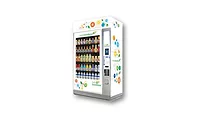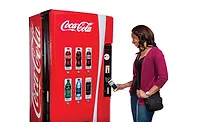Technology, government regulations change vending industry
Millennials drive vending channel changes
Smart technology, government mandates and consumer expectations are changing the face of the vending channel. Despite slow changes, the industry is making positive progress. The vending channel declined 12 percent during the 2009 recession, but only 1 percent in 2013.
“There is a net loss in sales. Even though kids can drink healthier beverages, they prefer the sugary options so they will go to the convenience store to get what they want. Snack providers are seeing the same,” says Chuck Reed, senior director sales and marketing, Crane Payment Innovations, Malvern, Pa.
In fact, the 2014-2015 school year was the first year in which school districts had to meet the “Smart Snacks in School” rule put in place by the U.S. Department of Agriculture. According to USDA, all foods sold on school campuses – including vending machines – must now meet specific nutritional standards.
Those standards include: plain water; unflavored low-fat milk; unflavored fat-free milk and milk alternatives; 100-percent fruit or vegetable juice; 100-percent fruit or vegetable juice diluted by water; no more than 20 ounces of calorie-free flavored water or other carbonated beverages; and no more than 12 ounces of beverages with more than 40 calories per 8 ounces or more than 60 calories per 12 ounces.
Nick Yates, chairman and founder of San Diego-based Fresh Healthy, finds that overall the younger generation is more educated on the impact that sugary sodas have on obesity, and that the health market is the fastest growing channel. In addition, there has been an increase in companies focusing on the health of their employees, which also is affecting healthy vending options.
“Corporate wellness programs are the norm for companies with more than 100 employees. It increases productivity and reduces absences,”
Yates adds.
The U.S. Vending Report by Euromonitor agrees with Yates’ assessment. According to the report, “health and wellness foodstuffs are expected to be one of the fastest growing areas of packaged foods and vending operators can increase their sales by aligning with these consumers’ desires.”
Technology takes over
With this shift in products, vending companies are getting smarter about what to offer and where. More companies are testing what consumers are buying and not buying. In addition, they can figure out the likelihood that a consumer will buy product B if they buy product A. “There’s a lot of data that can show which products are preferred. For example, it can show that if you bought product A you might also buy product B and C. It’s similar to buying a product on Amazon and getting product recommendations based off that purchase,” Rinaldo Spinella, executive vice president of strategic accounts, Apriva, Scottsdale, Ariz, says.
This technology is driven in part by what millennial customers are used to having in their purchasing experience. They like the convenience of the shopping cart experience, which allows them to buy more at a time.
“Millennials are ideal consumers for refreshment services. We offer reliable, convenient, affordable snack and beverage options, all at the touch of a button,” Roni Moore, vice president, marketing and communications, National Automatic Merchandising Association, says. “This generation has grown up with technology that allows them to define their own experiences. They love the anonymity and the ability to get what they want, when they want it.”
Millennials also prefer – and expect – cashless options. This consumer rarely carries cash and rarely goes anywhere without their smartphones. Additionally, they are the largest influencers in Apple Pay and Google Wallet payment options.
However, it’s important to note that cashless options aren’t completely taking over the way consumers pay. In fact, in 2014 the Federal Reserve Bank of San Francisco published a paper that showed a strong connection between the use of cash and
low-value transactions; if the amount of the transaction is less than $20, the probability of the consumer using cash increases to 91 percent, according to the paper. “Consumer Preferences and the Use of Cash: Evidence from the Diary of Consumer Payments Choice.”
Vending operators need to provide all types of payment options, Spinella says. “Cash is becoming less preferred, but there’s more hype around that than is realistically happening.”
The challenge is breaking the existing paradigm that vending machines must take bills and coins, adds Lance Sigal, sales and marketing demand manager, SandenVendo America, Dallas. “Eventually, we expect our industry to be fully cashless. It’s just a matter of time.”
The issue of wireless connectivity is a concern with machines that feature mobile payment options. Machine owners need to keep in mind the placement of their machines and access to these cell signals so they can complete transactions. For example, can a machine placed in a dorm basement receive a signal to facilitate making mobile payments?
Smart technology
Beyond the way machines accept money, technology is taking over the display. Many vending machines now have interactive displays that show advertisements, do targeted advertising and ultimately provide a user experience.
“There are nice displays [in the market]. They can help consumers by displaying nutritional information, data, advertisements and digital signage,” Spinella says.
Eventually the market might see targeted advertising by way of facial recognition that is being tested in the snack channel.
The vending channel is becoming smarter and more efficient with the use of technologies that provide route and product information. No longer does a Pepsi distributor need to visit every machine to check its stock. Route operation management systems provide distributors with information on which machines are low on product and which products specifically are low. They can also be notified of upcoming expiration dates.
Additionally, this technology allows for more product testing by providing data on which products are and aren’t in demand. It also enables distributors to manage more machines because they are more efficiently managed.
Slow and steady progress
The future of the vending channel will include a growth in micro-markets driven in part by millennial consumers. “This is something vending didn’t foresee. Mini-markets are allowing for more products to be sold,” Yates says. “Millennials are more comfortable with technology and expect self-checkouts.”
Micro-markets are also benefitting from the move away from standard packaging. “We’re seeing a distinctive shift towards micro-markets, which allows operators to offer a wider variety of options including healthier food, more profitable package sizes, and flexible payment options,” Sigal says.
Because the vending channel is so large and established, changes will be slow. Operators will need time to evaluate technologies, test what works and doesn’t work for their target markets, and embrace smarter processes.
The vending channel should continue to rely on the assistance of NAMA as they move through these changes. “We will deliver resources including research and advocacy to foster growth of our member companies,” Moore adds. “Growth can only be achieved with a laser-like focus on the consumer and that means providing snack and beverage choices they want.”
Looking for a reprint of this article?
From high-res PDFs to custom plaques, order your copy today!





